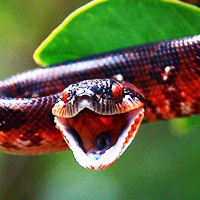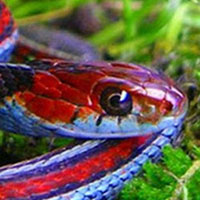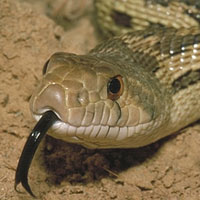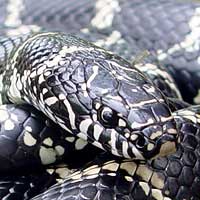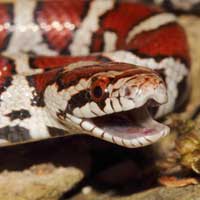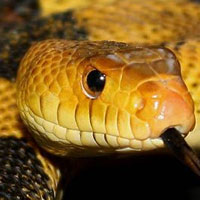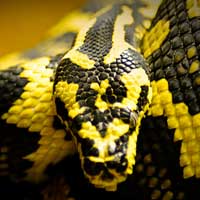Unveiling the Wonders of the Green Tree Python
The scientific name of the Green Tree Python is Morelia viridis, and it belongs to the Pythonidae family, which consists of non-venomous constricting snakes commonly referred to as pythons.
Scientific Name: Morelia viridis
Snake Family: Pythonidae
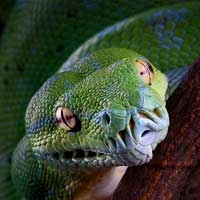
Introduction to the Green Tree Python
The Green Tree Python (Morelia viridis) is a non-venomous, arboreal snake celebrated for its vibrant green coloration and captivating coiled posture on branches. Native to the rainforests of New Guinea, Indonesia, and northern Australia, this species is a favorite among reptile enthusiasts due to its striking appearance and manageable size. This guide covers all you need to know about the Green Tree Python, from its natural habitat to its care in captivity.
The Natural Habitat of the Green Tree Python
The Green Tree Python thrives in tropical rainforests, where its environment influences its behavior and care needs. Understanding its habitat is essential for providing the right conditions in captivity.
- Geographic Range: Found in New Guinea, parts of Indonesia, and northern Australia.
- Preferred Habitat: Dense rainforests, mangroves, and lowland jungles.
- Climate: Warm and humid, with temperatures ranging from 75°F to 88°F.
| Region | Habitat Type | Key Features |
|---|---|---|
| New Guinea | Rainforest | High humidity, dense foliage |
| Indonesia | Mangroves | Wet and tropical environment |
| Northern Australia | Lowland Jungles | Warm temperatures, abundant prey |
Diet and Feeding Habits of the Green Tree Python
The Green Tree Python is a carnivorous predator with a diet primarily consisting of small mammals and birds. In captivity, its feeding needs are straightforward when managed correctly.
- Natural Diet: Small mammals, birds, and reptiles.
- Feeding Frequency:
- Juveniles: Every 5-7 days to support growth.
- Adults: Every 10-14 days, depending on size and activity level.
- Captive Feeding Tips:
- Offer pre-killed, thawed rodents for safety and convenience.
- Feed at night to mimic natural hunting behavior.
- Monitor for overfeeding to prevent obesity.
Behavior and Temperament of the Green Tree Python
The Green Tree Python is known for its calm and curious nature. However, its arboreal lifestyle and unique behavior require careful observation and understanding.
- Activity Patterns: Primarily nocturnal, with hunting and movement occurring during the night.
- Defensive Behavior: May strike if threatened but usually remains calm when unprovoked.
- Interaction with Humans: Best suited for observation, as it prefers minimal handling.
By respecting its natural instincts, you can ensure a healthy and stress-free life for your Green Tree Python.
Health and Lifespan of the Green Tree Python
The Green Tree Python can live 15-20 years in captivity with proper care. Regular monitoring and maintaining optimal conditions are crucial for its health and longevity.
- Common Health Issues:
- Respiratory infections from low humidity or cold temperatures.
- Shedding problems due to insufficient humidity.
- Stress-related conditions from improper handling or environment.
- Preventive Measures:
- Maintain humidity levels between 60-80%.
- Provide a temperature gradient with basking spots at 86°F-88°F.
- Ensure a clean enclosure and regular health checks.
Reproduction and Breeding of the Green Tree Python
The Green Tree Python is oviparous, laying eggs during the breeding season. Successful breeding in captivity requires attention to environmental cues and precise conditions.
- Mating Season: Typically during the cooler months.
- Clutch Size: 10-25 eggs per clutch.
- Incubation Period: 50-65 days at temperatures of 86°F-88°F.
- Breeding Tips:
- Simulate seasonal changes to encourage mating behavior.
- Provide a nesting box with moist substrate for egg-laying.
- Monitor temperature and humidity closely during incubation.
Handling and Caring for a Green Tree Python
Handling and caring for a Green Tree Python requires patience and a deep understanding of its natural behavior. With proper care, this species can thrive in captivity.
- Enclosure Requirements:
- Minimum size: 3’ x 2’ x 2’ for adults.
- Include branches for climbing and perching.
- Maintain a secure enclosure with proper ventilation.
- Handling Tips:
- Limit handling to reduce stress.
- Use a snake hook for safety during enclosure cleaning.
- Wash hands before and after handling to maintain hygiene.
By meeting their specific needs, the Green Tree Python can be a captivating and rewarding addition to any reptile collection.
Other Snakes In This Species
 Amethystine Python
Amethystine Python Ball Python
Ball Python Black-Headed Python
Black-Headed Python Boelens Python
Boelens Python Borneo Blood Python
Borneo Blood Python Burmese Python
Burmese Python Burrowing Python
Burrowing Python Centralian Python
Centralian Python Childrens Python
Childrens Python Coastal Carpet Python
Coastal Carpet Python Diamond Python
Diamond Python Green Tree Python
Green Tree Python Indian Python
Indian Python Inland Carpet Python
Inland Carpet Python Jungle Carpet Python
Jungle Carpet Python Macklots Python
Macklots Python Malaysian Blood Python
Malaysian Blood Python Olive Python
Olive Python Pygmy Python
Pygmy Python Reticulated Python
Reticulated Python Ringed Python
Ringed Python Rock Python
Rock Python Rough Scaled Python
Rough Scaled Python Spotted Python
Spotted Python Sumatran Blood Python
Sumatran Blood Python Timor Python
Timor Python White Lipped Python
White Lipped Python
